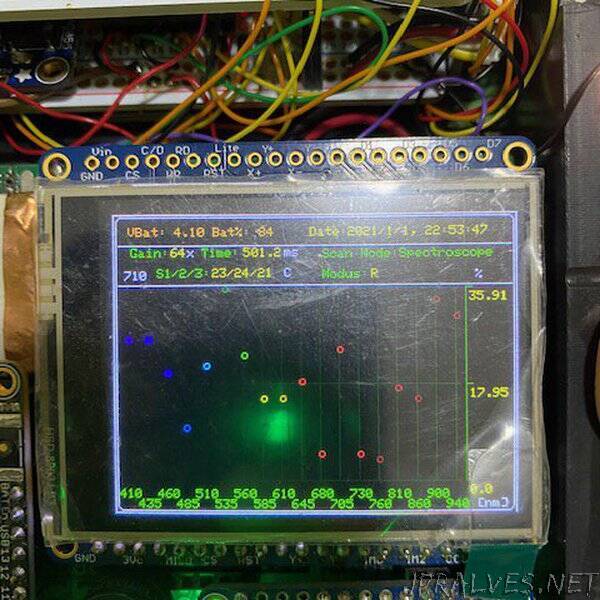
“This project describes the development of a multi-mode scanner platform, which can be described as a Scientific Tricorder.
A few years ago, after taking my first contacts with embedded electronics, I decided it would be time to try building a Tricorder. My first option was to use arduino. I’m definitely not an expert, so I designed my project based much more on concepts like; Sketch simplicity, ease of assembly and possibility of miniaturization. I am aware that an expert can design something much more efficiently. Initially, I built Tricorduino 1.0 and 2.0, using arduino mega and some sensors. These prototypes work with almost no graphical resources and limiting Sketch to reading some sensors, with numerical values printed. I have recently broadened my knowledge a bit and significantly improved the graphical display of screens with Tricorduino-3.0. Using Feather MO adalogger, this platform was initially based in the project - Science Tricorder by Olympus Heavy Industries Gallery, created byQueadlunn. New sensors and new features have significantly expanded the instrument’s potential.
1.0 - What would be a Tricorder
I met many scientists, some internationally renowned, who were not afraid to say that their work had some influence from science fiction. In fact, Science Reality contains a lot of inspiration from Science Fiction. In this context, the fiction of the Startrek’s universe is almost a gift of inspiration. Obviously much of Startrek’s fictional universe is pure poetic license using writer’s jargon, but on the other hand much is potentially useful to be scientifically explored and technologically worked. An interesting example is the Tricorder whose function is to evaluate in detail the environment being explored. The concept of Tricorder is not an academic concept because the instrument was conceived within a fictional universe. So, defining a concept for the Tricorder within our scientific reality at least for now is a matter of much more personal interpretation. My personal view, based on all the episodes I’ve could watch, is that a Tricorder lets us extend the human senses to what we can see and hear. However, more than that, it also allows for clarification of completely stranger things based on the crossing of information from not so stranger things. So, a Tricorder is not simply a collection of sensors, but a small computer with a vestige of artificial intelligence to process known things and get information for unknown things. But what are known things and what are unknown things? This is a difficult question to answer because the definition of known and unknown is inherent at the human consciousness. Sometimes an unknown thing is just a different composition of known things. For example, we may find a metal alloy completely unknown to our technology, but it must certainly be made of known metals. Similarly, we can find a polymer composite completely unknown to our technology, but certainly its integral components are known. This should be so because we know that the Periodic Table is closed within physical and chemical limitations to the laws of our universe. This means that a Tricorder could tell us what a metal alloy is made of or what the chemical components of a polymer composite are, but any information will be based on the periodic table that is well known a priori. Another different example can be drawn from a hypothetical situation. Imagine that an unidentified flying object appears to our eyes only as a body of light. A Tricorder can analyze the object by evaluating the magnetic field, electric field, radiation, temperature, electromagnetic spectrum, heat and sound emitted by it. The intersection of this information can delineate the nature of the object and help to understand what it can be, much more than our simple senses. Of course, this is a totally hypothetical but fully feasible situation. In that case, the Tricorder will evaluate known effects and define the unknown, or at least help our brain to do so. The fact is, we don’t have this kind of instrument yet, at least not yet the size of a cell phone. It may be possible to do all of this using a set of equipment from a super lab with the help of several computers. However, before this is possible we must go through the sensor collection stage. Through miniaturized processors and chemical and electronic sensors, it is already possible to build Tricorder prototypes in reasonable dimensions for operational use. I think we can call this Proto Tricorders.
Electronic sensors are widely available and are sold in small practical instruments for different tasks. We can find thermometers, thermal cameras, ultrasonic measuring tapes and others that are used daily by different professionals. In this context, cell phones are Proto Tricorders because apps often work within the principles that govern the definition of a Tricorder. It is all a matter of practical utility. Thinking this way, a Tricorder can be very practical and usual even if it is not used on other planets. In other words, a Tricorder can be very useful for soldiers, engineers, firefighters, boy scouts, campers, police officers, farmers, truck drivers and explorers in general. But in this case, why don’t we have Tricorders to sell in stores out there. The answer is quite simple, only now has technology become conducive to this kind of instrument. The advent of miniaturized processors and embedded electronics such as Arduino allows to gather several sensors in one instrument. I emphasize again that this is not exactly a Tricorder from Startrek series yet, but it is already a Proto Tricorder. Perhaps that was not possible 20 years ago. What awaits us for 20 years from now. Which will tell to 2260, fictional time where happens the mission of 5 years of the classic series of Startrek. “
